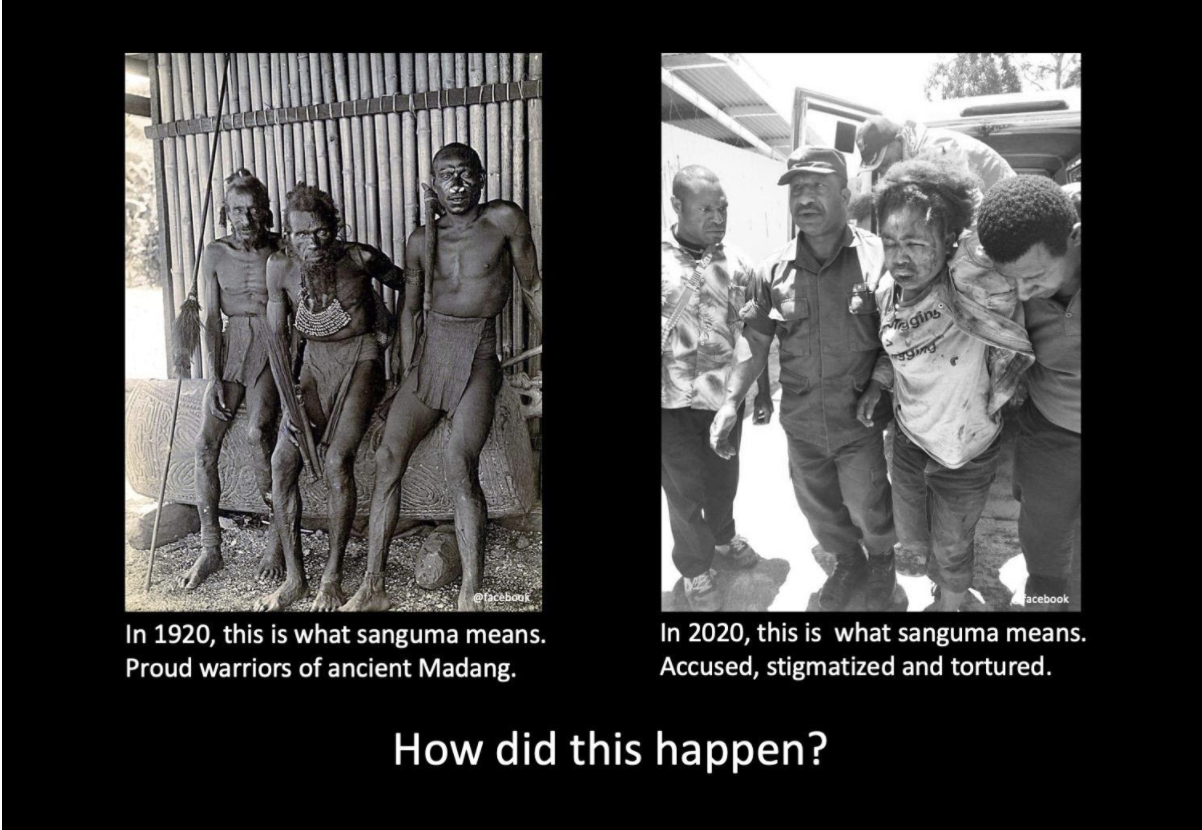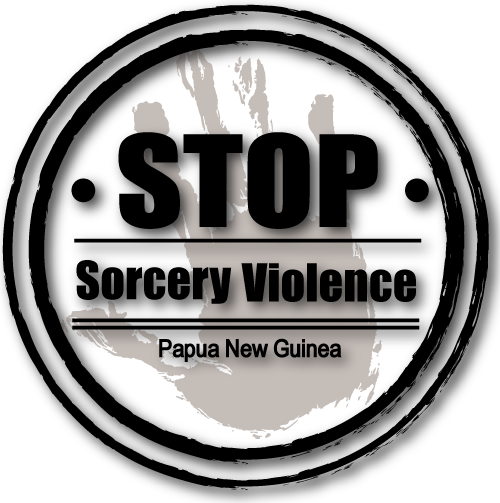The Sanguma Story

by Anton Lutz
Words matter
In the last blog post, we spoke briefly about how the way we use our words matters a great deal when it comes to understanding and communicating about Sorcery Accusation Related Violence (SARV). Unless we know what our words mean, we can easily misunderstand one another.
Today we will take a first look at one of the most interesting SARV words – Sanguma.
Let us think back to when Tok Pisin was just getting started in the early 1900s. The German colonial administration allowed the missionaries and plantation owners to gather together people from different tribes and language groups – including from all over the Pacific – into small communities. You had policemen,‘wok-bois’, plantation workers, carriers on patrols and translators who all needed to be able to communicate together. Before long, an early version of Tok Pisin began to develop. We still tell jokes all over Papua New Guinea about the hilarious ways that this early communication went wrong and how the coconut trees didn’t get counted because ‘mi kaunim go na namba sot’, and how soap got put into the mumu instead of salt.
Back then, people were encountering each other’s ideas for the first time, meeting new people, hearing new words, and trying to figure out what it all meant. Once their time on the plantation or mission station was finished, many workers returned to their villages, taking the new ideas, and Tok Pisin, with them. And so, isi isi, Tok Pisin began to organically spread throughout what would become Papua New Guinea.
Which brings us to the strange case of the word sanguma. Today it is used in many different ways. But where did it come from? What did the word mean before it came into Tok Pisin?
Sanguma’s asples and original meaning
Many of us, of course, know by now that the word sanguma comes from the inland area near Bogia, in Madang Province. In the Monumbo tok ples more than a hundred years ago, the word “tsangumo” meant violence by means of magic. This is a rather broad definition – and ideas and words can and must change over time – so let us try to dig a little deeper and find out what kind of violence and what kind of magic the Monumbo people were talking about when they used this word tsangumo.
The tsangumo, as per the original meaning, is apparently a team of men who have gone through special training in haus man, so that they are now able to assassinate their enemies in especially horrible ways. They’re famous for being able to move around unseen, perhaps even magically. They can twist up their victim’s intestines with bamboo tongs, or punch holes in their skulls.
Imagine one day the tsangumo attack a victim – let’s call him Bob – who lives on a plantation. Bob then returns to his home and tells his family that ‘ol tsangumo kilim mi pinis!’ Fear grips the community! Within a day or two, poor Bob dies. Another successful tsangumo attack.
Now just imagine the clueless German colonial guy – let’s call him Klaus – standing there, wondering what just happened. The foreman tells him that Bob can’t count coconut trees today because ‘the tsangumo killed Bob.’ Klaus is now wondering, what does this sentence even mean?
Was Bob a) killed by a witch who has gained power by selling her soul to the devil?
b) killed by a sorcerer?
c) killed by some physical sickness like typhoid-malaria?
d) murdered by a person?
e) killed by fear and worry and psychosocial stress?
f) killed by a demon who is living inside a local woman?
Do you see? These are all different ways to die! Next time should Klaus call a doctor? A policeman? An exorcist or psychologist? Is Klaus at risk too? So now, yumi skelim. All the other New Guineans living with Klaus at the station are even more terrified. They too have their own cultural understandings of how sorcery works and why people die and without very, very, very clear communication, they have no way to understand what this new word tsangumo means.
So the next day, Klaus decided to investigate by asking sensible questions.
How did this hole appear in Bob’s skull?
Was it made by a drill or a chisel or an especially large trained cockroach?
Was Bob struggling or was he unconscious when it happened?
Was he forced to eat something poisonous?
Was something inserted into his body?
Bit by bit, Klaus discovered that tsangumo means physical assault which mortally injures the victim, who does not die for several days. True, the Monumbo men had to graduate from haus man to be able to carry out these attacks, and true, they talked about how they moved in the darkness with the help of their ancestral spirits, but what these trained human men actually did was physically attack and murder poor Bob.
Even today, when you ask people from the Bogia area what sanguma means, this is what you will hear. To them, sanguma is /tsangumo/, which is what trained men do, physically and with the support of spiritual forces, to their victims’ bodies and minds. These techniques must be learned from the living experts and applied correctly. Only trained and qualified men may conduct sanguma attacks on Bob, not just anyone! And there must be a proper reason.
So Monumbo tsangumo became Tok Pisin sanguma. Its meaning changed. How did a word which originally meant Ritual Physical Assault become a word which people now translate as ‘sorcery and witchcraft?’ Is that the best way to translate this word?
How sanguma became more than just tsangumo
Tok Pisin speakers began to accompany the patrols into the highlands. While the white skins were busy making maps, naming mountains after other white people and trading axes, the New Guinean carriers and policemen were meeting their fellow countrymen for the first time. Before long and with lots of hand gestures and confusion, words and meanings were being exchanged. One week later, everyone was very confident that they knew exactly what all of these words and meanings meant.
Except, of course, that miscommunication prevailed.
When they hiked their way through the Asaro valley, the Tok Pisin speakers encountered people who shook pieces of bamboo and ran about the village looking for who might have caused the sickness by doing some sort of violence by way of magic. Sanguma! When they hiked over Daulo Pass and down into the Waghi valleys, they met people who built tufts on their house roofs, hoping that flying spirits would use them to land upon and climb back into the houses. Sometimes, they believed, these spirits went wild and made others get sick and die and so, in retaliation, the human hosts would have to be killed. Sounds weird? Sounds like violence by way of magic. Call it sanguma! Keep hiking!
The word and the idea of sanguma gathered more and more layers of meaning as people carried it and used it from one end of the island to the other.
For instance, when European Christian Bible translators sat around trying to decide how to translate a verse in Deuteronomy 18:10, where it mentions “sorcery and divination” into Tok Pisin. Harry, a translator who had learned Tok Pisin in the Eastern Highlands where they called their bamboo techniques “sanguma“, said “Let’s use the word sanguma“. So there it is, sanguma, right in the Bible. As if God Yahweh was telling the Hebrew tribes about Simbu kumo spirits that eat human hearts or about Monumbo ritual killings of tribal enemies.
What the Bible was actually talking about, and how Christians today can think fruitfully about these things, can be something we cover in another post.
By my way of counting, there are at least 6 distinct meanings of sanguma right now in Papua New Guinea.
- trained ritual killers (the original meaning of sanguma – Monumbo language)
- shaman / witchdoctor / sorcerer (similar to what some call posin man)
- witchcraft (a truly confusing insertion to this whole discussion but a word which journalists and English speakers of all kinds insist on tossing into the conversation)
- a human who is possessed by a demon (what some Christians claim)
- a human who is inhabited by ancient, invisible, flying, contagious creatures which eat other people’s hearts (what some people in the Highlands believe)
- false accusations against innocent people for selfish reasons (how often is this happening?)
Many people basically smash these ideas together, apparently believing it is just versions of the same thing. But is that the best approach?
A future research project would allow someone to map each of these various understandings of sanguma to different places in the country, to different demographic groups, even to different religious groups. Unfortunately, that project has yet to happen and the lack of precision in our language prevails.
Summing up sanguma
People in Papua New Guinea believe in sanguma. Ask them what they mean, however, and be prepared for strange and diverse stories. Some people believe more than one of these definitions is true. Some even claim that all of them might be true. Very few sanguma believers seem to be separating the threads and pointing out which meanings are imaginary and which ones are real. Instead, they mix up the different beliefs, often in the same couple of sentences.
How does this play out in practice? Yumi traim skelim.
People say sanguma is something one has, what lives inside you. Em gat sanguma. Sanguma blo em kaikaim em.
Sanguma is something one does, an action. Em wokim sanguma. Em mekim pasin sanguma. Em sangumaim em. Em kaikaim em.
Sanguma is something one is, who you are. Em sanguma.
This variation in language reveals the rich history of a word, of the ideas hidden behind the word. When we understand this history and the layers and variations within it, how does this change how we think about it? Are we even more convinced that every story must be true? Are we willing to reconsider the stories we have heard on the PMV buses and in the smoky houses, asking what exactly people are claiming and what their evidence for these claims actually is?
Once we know the story behind sanguma, it’s hard to automatically believe any old sanguma story. We’re going to have a lot more questions. And that’s exactly as it should be – questioning anything that might harm another human being.
In my next blog, I’ll cover the reasons as to why it’s so hard to talk about SARV. Stay tuned!
